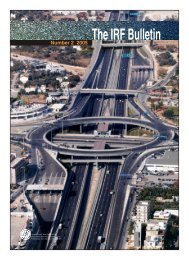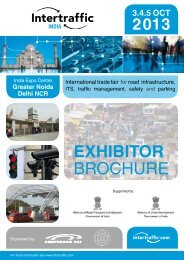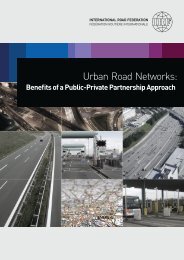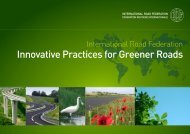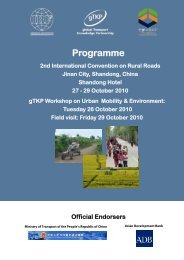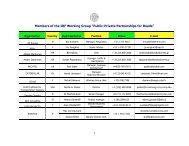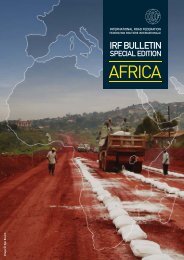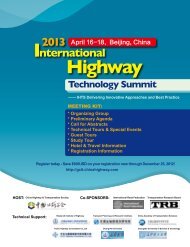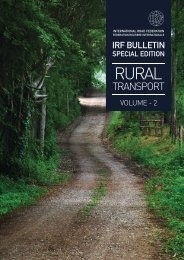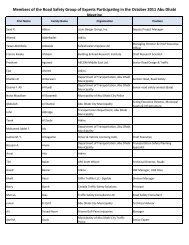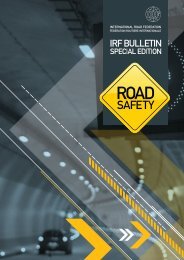Download - IRF | International Road Federation
Download - IRF | International Road Federation
Download - IRF | International Road Federation
Create successful ePaper yourself
Turn your PDF publications into a flip-book with our unique Google optimized e-Paper software.
EDITORIAL<br />
EDITORIAL<br />
There is no region of the world where disparities of infrastructure development and wealth distribution are<br />
as evident as in the Asia and Pacific region. From the hyper technological metropolis to remote and<br />
inaccessible villages, this vast region is a real challenge for transport planners and operators and certainly<br />
requires innovative and imaginative thinking.<br />
The opening and on-going rapid growth of China, India and other Asian economies have created new chances and<br />
challenges. The revival of the Silk <strong>Road</strong> is now a matter of economic necessity. <strong>Road</strong> transport is very often the only<br />
possibility to carry vital foreign trade between Asian states, particularly those that are land-locked.<br />
The urgency for infrastructure development is as evident in Central Asia as it is in New Delhi or Papua New Guinea. It is<br />
crucial to the economic development and the quality of life of every single citizen.<br />
<strong>Road</strong> safety is still the missing protagonist in the growing demand for mobility that this region is experiencing. If you<br />
think that India alone accounts for 10% of the 1.2 million deaths caused by road accidents, you can easily understand<br />
the size of the problem.<br />
Investment in road infrastructure has been worldwide identified as one of the major tools for reversing the recession<br />
trend in the economy. Substantial financing is certainly needed to secure infrastructure, but we should not forget that<br />
this is only part of the solution. Global processes require global responses. Framework instruments like the ones<br />
developed by the United Nations are essential to address major challenges, such as harmonization of border crossing<br />
procedures or road safety issues. But these instruments must be adjusted to local experiences in order to be effective and<br />
to translate vision into reality.<br />
In this spirit, the <strong>International</strong> <strong>Road</strong> <strong>Federation</strong> has just inaugurated an <strong>IRF</strong> India Chapter in New Delhi, of which I have<br />
the honour to be the Chairman. The <strong>IRF</strong> has helped with the years to raise awareness on the specific needs of this region<br />
of the world and encouraged governments to intensify efforts to improve the sustainability of their transport systems.<br />
At the same time it has been instrumental in building the relationship between local authorities and international and<br />
regional organizations. With this new office, the <strong>IRF</strong> wishes to reinforce and broaden its presence in the region and<br />
ensure that recommendations are translated into practicable action at the earliest.<br />
A famous maxim from Lao Tzu says that a thousand mile journey starts with a single step. This Bulletin will accompany<br />
you in a tour around this promising region<br />
Kiran K. Kapila<br />
Vice Chairman <strong>IRF</strong> Geneva<br />
Chairman of <strong>IRF</strong> India Office<br />
<strong>IRF</strong> BULLETIN SPECIAL EDITION : ASIA & OCEANIA<br />
02



